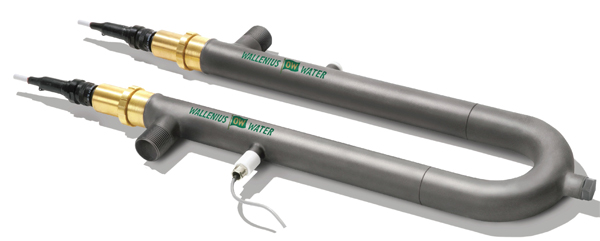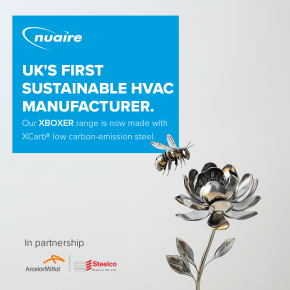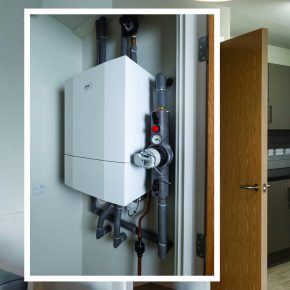
Pseudomonas – the scourge of our water systems
Water hygiene is not just about safeguarding people, the HVAC equipment and systems that rely on it also need protecting, with bacteria-laden water causing inefficiencies, corrosion and breakdowns.
One of the key culprits is Pseudomonas, a relatively recent problem that was largely confined to London. As Pseudomonas increasingly finds a home in buildings throughout the UK, Steven Booth, associate director for Guardian Water Treatment, looks at how to control its spread…
Pseudomonas is a family of waterborne bacteria responsible for HVAC system fouling – a particular problem in closedcircuit systems. Until recently, Pseudomonas was described as the London problem and was of little concern for the rest of the country.
Fast forward to 2016 and this bacteria is making an appearance throughout the UK, causing significant damage in closed-circuit water systems, in particular.
While Pseudomonas can be harmful to health, in a closed system, humans are rarely exposed, so the main issue is the damage it does to HVAC equipment. In order to prevent it, care must be taken in a water system’s design, pre-commissioning cleaning is essential and ongoing maintenance must be planned and fit for purpose.
Pseudomonas’ habitat
Any stagnant or low flowing water will give Pseudomonas an ideal environment in which to grow and multiply leading to biofilm formation and other problems, such as corrosion and the rise of Sulphate Reducing Bacteria (SRBs).
SRBs: SRBs metabolise naturally occurring sulphate in the water to produce sulphide under clumps of bacteria, depolarising the metal surface, resulting in localised pitting corrosion and eventual perforation.
Biofilm: In general, bacterial build-up in the water, especially in stagnant areas, can create a microbial biofilm layer on pipe and heat exchanger surfaces, causing a reduction in efficiency and flow restrictions. Preventing biofilm from forming in the first place is essential; once biofilms start to form, the bacteria that reside within them can be thousands of times more resistant to biocides than that found free floating in the water.

“Any stagnant or low flowing water will give Pseudomonas the perfect conditions to grow and multiply leading to biofilm formation and other problems, such as corrosion…”
Pseudomonas can be particularly problematic in modern buildings with the small-bore pipework and small orifices associated with control valves. The biofilm reduces water flow and provides a habitat for other corrosion-inducing bacteria that will lead to pitting and leaking pipework. The net result of Pseudomonas in heating and chilled water systems is a decrease in their efficiency and increased down time and costs from repairing leaks.
Preventing Pseudomonas
Preventing Pseudomonas begins with how a water system is designed. Cutting corners at this crucial stage will lead to problems further down the line. Design problems can include dead legs and capped pipes, added to allow for further expansion, but creating the ideal stagnant conditions for Pseudomonas to grow. If unavoidable, these must be looped out and circulated regularly.
Once installed, new water systems must undergo precommissioning cleaning, in-line with BSRIA guidelines. By making sure a water system is clean from the outset, unnecessary maintenance and repairs can be avoided. Remediation cleaning is possible but it will never render a system as new.
Chemicals flush out the system and then provide ongoing water treatment, with regular dosing the normal course of action. While biocides are effective, they should be used with caution and only where necessary. Potentially harmful to maintenance operatives and pipework, a bespoke approach is always best, with a water system continually monitored so dosing is based on actual requirements, rather than a one-size-fits-all approach.
If possible, non-chemical alternatives should be explored, which can be installed when a water system is being built, acting as a gate keeper to mains water, or retrofitted to existing systems. For example, one version harnesses a specific frequency of light and photocatalytic surfaces to create free radicals that break down harmful microorganisms.
Extremely low energy, this allows buildings to cut down or even eliminate their reliance on dosing, thus contributing to improving water hygiene’s green credentials and reducing chemical and maintenance costs.
Going the extra mile
Water treatment companies are often called out to treat water in buildings where problems could have been prevented if more thought had been taken at the construction stage, with better handover to maintenance staff following pre-commissioning cleaning.
It is not that designers are getting it wrong, per se, more that the guidelines they follow don’t go far enough. As long as they are met on completion, long term water system usage is not considered, with cost savings outweighing whole-life water hygiene (as mentioned, these cost savings are often superficial, too). To prevent Pseudomonas we need to go the extra mile; water hygiene should not be an afterthought but an integral part of how our buildings operate.
Latest news

28th April 2025
Nuaire first UK ventilation manufacturer to use low carbon-emissions recycled & renewably produced steel
Nuaire has announced that its Magnelis® steel based ventilations systems are now being made from XCarb® recycled and renewably produced steel.
Posted in Air Conditioning, Articles, Building Industry News, Building Products & Structures, Building Services, Building Systems, Heating, Ventilation and Air Conditioning - HVAC, Restoration & Refurbishment, Retrofit & Renovation, Steel and Structural Frames, Sustainability & Energy Efficiency, Waste Management & Recycling
28th April 2025
Renderplas: Builders avoid costly remedial work with PVCu render beads
A pioneer of PVCu render beads, Renderplas is helping the construction industry avoid the costly remedial work associated with rusting steel designs…
Posted in Articles, Building Industry News, Building Products & Structures, Building Services, Building Systems, Facades, Posts, Render, Restoration & Refurbishment, Retrofit & Renovation, Sustainability & Energy Efficiency, Walls
28th April 2025
How Celotex’s Technical Team adds value through expert insulation support
From U-value calculations to real-world installation support, Celotex’s technical team helps construction professionals specify and install insulation with confidence…
Posted in Articles, Building Industry News, Building Products & Structures, Building Services, Insulation, Research & Materials Testing, Restoration & Refurbishment, Retrofit & Renovation, Sustainability & Energy Efficiency, Walls
28th April 2025
Ideal Heating Commercial takes extra care with the heat network at Huddersfield specialist housing development
Ideal Heating Commercial POD Heat Interface Units (HIUs) and Evomax 2 condensing boilers have been installed into Ash View Extra Care in Huddersfield.
Posted in Articles, Building Industry News, Building Products & Structures, Building Services, Case Studies, Facility Management & Building Services, Heating Systems, Controls and Management, Heating, Ventilation and Air Conditioning - HVAC, Pipes & Fittings, Plumbing, Restoration & Refurbishment, Retrofit & Renovation
 Sign up:
Sign up: